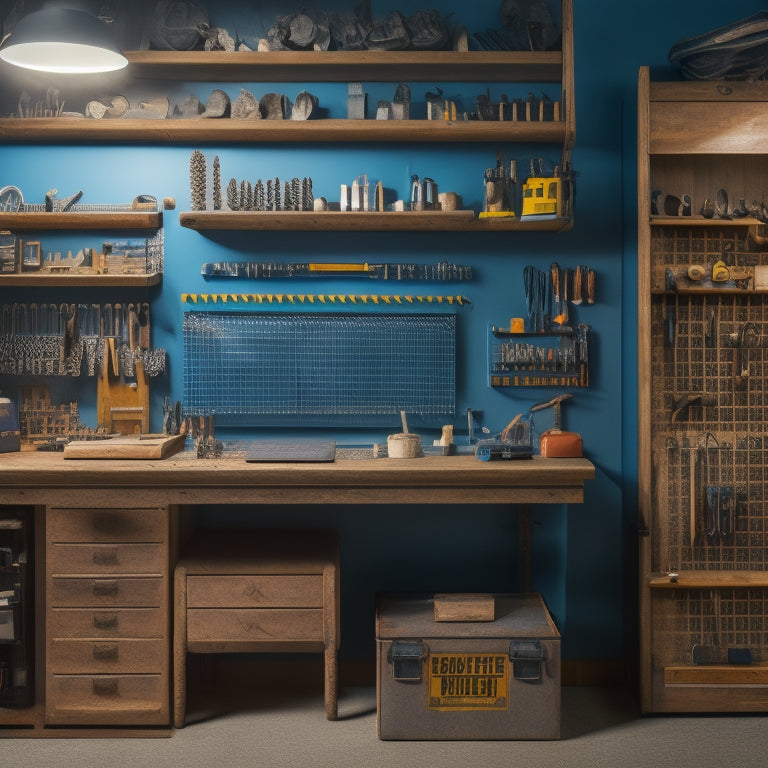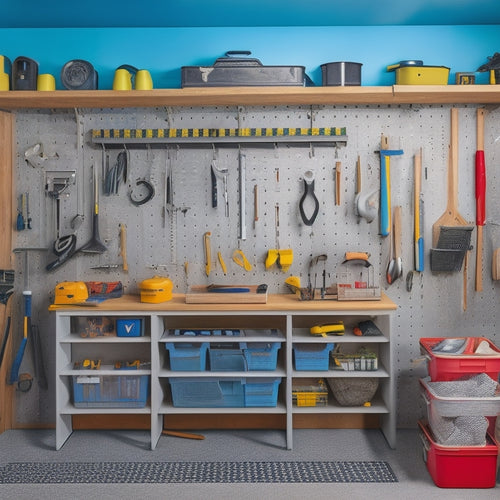
7 Essential Tool Organization Systems for Workshops
Share
You're tired of wasting time searching for misplaced tools in your cluttered workshop. To maximize efficiency, consider these 7 essential tool organization systems: pegboard systems for hanging tools, tool chest strategies with customizable dividers, workbench tray and drawer systems for streamlining your workflow, overhead storage racks to reclaim floor space, mobile tool carts for easy access, wall-mounted tool holders for organized storage, and cabinet and shelf organization ideas for categorizing supplies. By implementing these systems, you'll be able to find what you need quickly and easily, freeing up time to focus on the task at hand - and that's just the beginning.
Key Takeaways
• Assess tools based on size, frequency of use, and accessibility to create a tailored storage solution for each tool.
• Utilize vertical space with overhead storage racks, wall-mounted systems, and pegboards to maximize storage capacity.
• Implement a mix of fixed and mobile storage solutions, such as tool chests, cabinets, and carts, to accommodate diverse tool sets.
• Organize tools into categories, such as daily, occasional, and project-specific tools, to streamline workflow and reduce search time.
• Incorporate dividers, bins, and baskets to maintain order, prevent tool damage, and ensure easy access to tools and supplies.
Pegboard Systems for Maximum Storage
You can maximize your workshop's storage capacity by installing a pegboard system, which allows you to hang frequently used tools and accessories within easy reach. This setup enables you to optimize your workshop's layout, making it more efficient and organized.
A pegboard system typically consists of a tool wall with multiple pegboard hooks, where you can hang items like hammers, screwdrivers, pliers, and more. You can customize the layout to fit your specific needs, ensuring that the tools you use most often are readily available.
When choosing pegboard hooks, consider the type and size of the tools you'll be hanging. Look for hooks with a sturdy design and a smooth finish to prevent scratching or damaging your tools. You can also add bins and baskets to store small items like nuts, bolts, and fasteners.
Tool Chest Organization Strategies
When it comes organizing your tool chest, you'll want to assess the storage options that work best for you, such as small parts bins, trays, and dividers.
You'll also need to contemplate how to optimize your chest's drawer space with dividers and customizable tray systems that can be tailored to your specific toolset.
Tool Storage Options
A well-planned tool storage system starts with a thorough assessment of the tools you need to store, taking into account their size, frequency of use, and accessibility requirements. You'll want to identify the tools you use daily, those you use occasionally, and those that are only needed for specific projects. This will help you determine the most effective storage solutions for each type of tool.
For frequently used tools, consider installing tool wall racks or investing in tool cabinet solutions. These will keep your most essential tools within easy reach, saving you time and increasing your productivity.
For less frequently used tools, a mobile tool cart or overhead storage rack can be a great option. These provide additional storage without taking up valuable floor space.
When choosing a storage solution, think about the specific needs of each tool. For example, do you have tools that require a specific temperature or humidity level? Are there tools that need to be stored in a specific order or sequence? By considering these factors, you can create a tool storage system that meets your unique needs and helps you work more efficiently.
Chest Drawer Dividers
Your tool chest's drawers can become a cluttered nightmare if not properly organized, but incorporating chest drawer dividers can help maintain a sense of order and streamline your workflow. By separating tools into designated compartments, you'll reduce the time spent searching for specific tools and increase workshop efficiency.
Drawer dividers also prevent tools from getting jumbled and damaged, ensuring they remain in top condition.
When selecting chest drawer dividers, consider the types of tools you'll be storing and the size of your drawers. Adjustable dividers are ideal for accommodating tools of varying sizes, while fixed dividers provide a more structured approach to tool storage. You can also customize dividers to fit your specific needs, using materials like foam, wood, or metal.
Effective drawer organization is vital for workspace optimization. By keeping tools organized and easily accessible, you'll reduce clutter, increase productivity, and create a safer working environment.
With chest drawer dividers, you'll be able to find the tools you need quickly, allowing you to focus on the task at hand and provide better service to your clients.
Customizable Tray Systems
You can take your tool chest organization to the next level with customizable tray systems, which allow you to create a tailored storage solution that adapts to your unique tool set and workflow. This level of tool tray customization provides organizational flexibility, ensuring that each tool has its designated place, making it easy to find what you need when you need it.
With customizable tray systems, you can:
-
Design a layout that mirrors your workflow, reducing tool retrieval time and increasing productivity
-
Accommodate tools of varying sizes and shapes, maximizing storage capacity and minimizing wasted space
-
Easily reconfigure the tray system as your tool set evolves, ensuring that your storage solution remains efficient and effective
Workbench Tray and Drawer Systems
When setting up your workbench tray and drawer systems, you'll want to start by implementing a tool segregation strategy to keep similar tools and supplies separate and easy to find.
Next, consider using adjustable drawer dividers to customize the layout of your drawers and maximize storage space.
Tool Segregation Strategy
Organizing tools into workbench trays and drawer systems helps to create a logical and efficient tool segregation strategy, allowing you to quickly locate and access the tools you need. This approach guarantees that your workspace remains clutter-free, reducing the time spent searching for tools and increasing productivity.
By categorizing tools into specific groups, you can store them in designated areas, making it simpler to find what you need when you need it.
Here are some ways to implement a tool segregation strategy:
- Designate a specific area for frequently used tools, such as a tool rack near your workbench, for easy access.
- Use a tool cart with separate compartments to store tools that are used for specific tasks or projects.
- Label each compartment or tray to identify the tools stored within, making it simple to find what you need at a glance.
Adjustable Drawer Dividers
Installing adjustable drawer dividers in your workbench tray and drawer systems enables you to customize the storage space to fit your unique tool collection, maximizing storage capacity and minimizing clutter. This allows you to efficiently store and organize your tools, making it easier to find what you need when you need it. Adjustable drawer dividers are especially useful for tool cart organization, as they can be adjusted to fit different-sized tools and accessories.
When implementing drawer divider techniques, consider the types of tools you use most frequently and group them together in a single drawer or compartment. This will save you time and reduce frustration when searching for a specific tool.
You can also use adjustable drawer dividers to separate tools by category, such as hand tools, power tools, and fasteners. By customizing your storage space, you'll be able to maintain a more organized and efficient workshop, allowing you to focus on the tasks at hand.
With adjustable drawer dividers, you'll be able to optimize your tool storage and reduce clutter, making your workshop a more productive and enjoyable space.
Customizable Tray Configurations
You can take your tool organization to the next level by designing customizable tray configurations that complement your adjustable drawer dividers, allowing you to create a tailored storage system that caters to your specific workshop needs. This means you can maximize your workshop's efficiency by assigning a home to each tool, making it easy to find what you need when you need it.
Here are some benefits of customizable tray configurations:
-
Optimize your workbench layout: By designing trays that fit your specific tools, you can create a workstation that flows smoothly, reducing clutter and increasing productivity.
-
Streamline tool access: Customizable trays enable you to store frequently used tools in easy-to-reach locations, saving you time and energy.
-
Scale up or down: As your workshop evolves, you can easily adapt your tray configurations to accommodate new tools or projects, ensuring your storage system remains efficient and effective.
Overhead Storage Rack Solutions
Maximize your workshop's vertical space by incorporating overhead storage rack solutions that keep infrequently used items, like seasonal decorations or out-of-season tools, safely stowed away. This will free up valuable floor space and keep your workshop organized and clutter-free.
Consider installing ceiling hooks or wall-mounted racks to hang items like bikes, luggage, or equipment. You can also use hanging baskets to store smaller items like bins, bags, or accessories.
For a more customized solution, look into garage storage systems that can be tailored to your specific needs. These systems often come with adjustable shelves, bins, and hooks that can be configured to fit your unique requirements.
Mobile Tool Cart Organization
Five essential areas can be designated on your mobile tool cart to optimize its organization and functionality. By creating separate areas for different types of tools and supplies, you'll improve tool cart efficiency and streamline your workshop organization.
Here's how to allocate the areas:
-
Tool Area: Reserve the top shelf for frequently used hand tools, such as wrenches, pliers, and screwdrivers. This guarantees easy access and reduces clutter.
-
Supply Area: Designate a mid-level shelf for consumables like nuts, bolts, and fasteners. This keeps them organized and within reach.
-
Power Tool Area: Allocate the bottom shelf for larger power tools, such as drills and saws, to maintain tool accessibility and prevent overcrowding.
Wall-Mounted Tool Holder Systems
Now that your mobile tool cart is organized, consider taking your workshop organization to the next level by installing wall-mounted tool holder systems. These systems can help reclaim valuable floor space and keep frequently used tools within easy reach. They are perfect space-saving solutions, providing efficient organization and freeing up room for other essential tools and equipment.
You can choose from a variety of wall-mounted options, including pegboards, hooks, and slat walls. Pegboards are great for hanging tools like hammers, screwdrivers, and pliers, while hooks are ideal for storing items like hoses, cords, and accessories. Slat walls offer versatile storage for bins, baskets, and other containers.
Regardless of the option you choose, you'll appreciate the easy access to your tools, which will save you time and improve your productivity. By installing a wall-mounted tool holder system, you'll be able to quickly find and retrieve the tools you need, making your workshop a more efficient and enjoyable place to work.
Cabinet and Shelf Organization Ideas
Organize your workshop's cabinets and shelves by categorizing and grouping similar tools and supplies, keeping the most frequently used items in easy-to-reach locations. This will save you time and frustration when searching for the right tool.
To maximize storage space, consider the following ideas:
-
Use wire baskets to store small parts and accessories, keeping them visible and accessible.
-
Install hanging hooks for items like cords, hoses, or accessories, keeping them off the floor and out of the way.
-
Utilize stackable bins and tool racks to store larger items, such as power tools or equipment, and label them for easy identification.
Frequently Asked Questions
How Do I Prevent Tools From Getting Damaged in Storage?
Imagine rummaging through a cluttered toolbox, only to find your favorite wrench bent beyond recognition. To prevent damage, you're storing tools in designated compartments, using soft pouches, and implementing vertical storage solutions that keep them organized and protected.
Can I Customize Tool Organization Systems for My Specific Needs?
You can definitely customize tool organization systems to fit your specific needs, ensuring workshop efficiency by choosing from various storage solutions that cater to your unique requirements, and optimizing your space for maximum productivity.
Are Tool Organization Systems Suitable for Small Workshops?
You'll be surprised to know that 80% of small workshops struggle with clutter. Fortunately, tool organization systems are perfect for you, as they optimize space constraints, boost efficiency, and offer cost-effective, flexible solutions that fit your unique needs.
How Often Should I Clean and Maintain My Tool Organization System?
You should clean and maintain your tool organization system regularly, ideally weekly, to prevent dust buildup and damage. Set a maintenance schedule to guarantee storage protection, and check for worn-out parts to replace them promptly.
Can I Use Tool Organization Systems for Non-Traditional Tools?
You can repurpose tool organization systems for non-traditional tools, finding unique solutions for creative uses. Think beyond workshops: organize art supplies, musical instruments, or even kitchen gadgets with systems tailored to their specific needs.
Related Posts
-

Heavy-Duty Pegboard Hooks for Industrial Use
You need heavy-duty pegboard hooks that can withstand the rigors of industrial use, providing a reliable and efficien...
-

Advantages of a Pegboard System in Your Garage
You can instantly alter your garage into a more organized, efficient, and productive space by installing a pegboard s...
-

What Are the Advantages of a Wooden Tool Box
You choose a wooden tool box, you're not only getting a reliable storage solution, but also a long list of benefits t...


